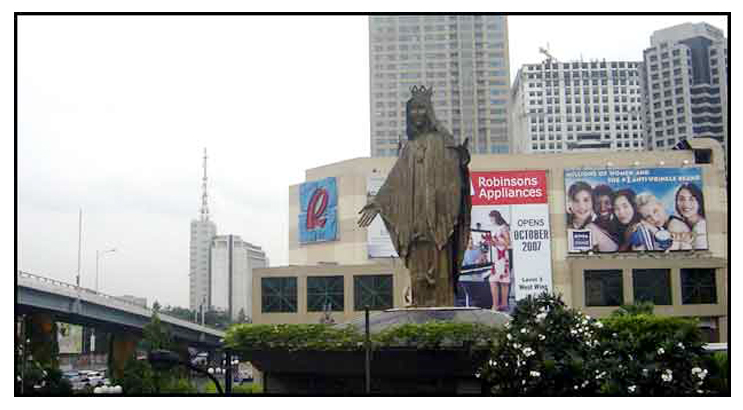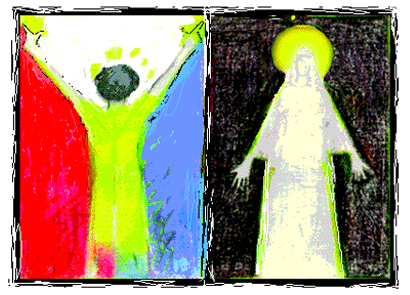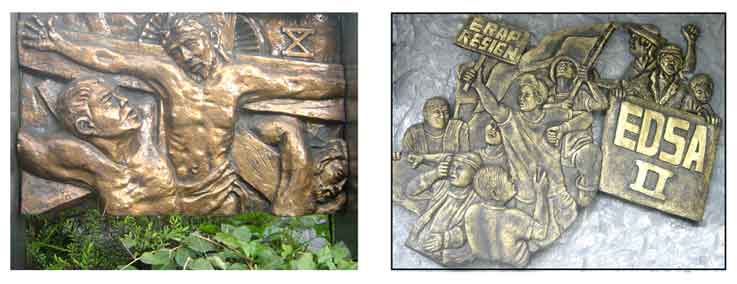The Edsa Shrine |
|||||
A Wasted Opportunity |
|||||
And in its wake, the birth of people power. Years before, when Ninoy was assassinated, I found
catharsis in doing a small collage artwork which I titled: WHERE ARE
THE HEROES? In those four EDSA days, the hero came to life. Alas, it was too grand, too sublime, too extraordinary a victory to attribute to the populace. In the epilogue, everyone started dipping their fingers into the hero-bowl. Attributions and claims came from all fronts: CIA (of course, always in the cast, real or imagined, that it orchestrated it), the high-end political defectors and military rebels (without us, it couldn't have happened), the burgis-power-elites (only because we allowed it to happen). In the end, the miracle brokers won. With nuns standing their grounds on advancing tanks, a Cardinal power-player, the bloodless coup, and a populace steeped in religiosity —it was no hard-sell—The Miracle of Edsa. A few years later, they built the Edsa Shrine. Personally, I was greatly disappointed. And it lingers.
Hey, I'm no miracle-hater. I like miracles. I like the inevitable clash
of the debunkers and the faithful, the desperate application of quantum
physics and singularities by the miracle slayers to the unabashed piety
and adoration of the worshipers. And I'm no anti-Marian zealot either.
Although I have became the nominal-situational Catholic, my roots are
severely Catholic. I can still recite half the mass in Latin. I have
a reassuring accumulation of plenary indulgences for my thanalogical
needs and was avidly Pro-venial sin and Pro-purgatory for my certain
detour needs on the way to heaven's gates. Whenever the opportunity,
I take Tiaong rural villagers to the Lady of Manaog shrine to invoke
Her help in ridding them of their dastardly addictions and aberrant
and sinful ways of life.
In a populist vein, I would have elected to erect a statue that is composite of the masa to include: Juan and Maria, a nun clutching at her rosary, a priest, a soldier, a boy and a girl, someone holding a Ninoy placard. All together, hand in hand. Maybe, even add Freddie Aguilar, for the music in the Pinoy's soul. And, a media person. Wow, the list is getting longer, the sculpture bigger. Any other country would have made hallowed ground of some part of EDSA — some expanse claimed for history. Perhaps, a people's park, tree-lined with benches and picnic grounds, to stroll and linger, for parents to bring their children to tell and re-tell the stories of those four days. Certainly, a small museum, replete with videos and audios and a gallery of photographs, where young men and women for whom EDSA 1986 is but a blurred snippet of history, can come, watch, learn and hear of the masa's collective heroism of those four days. Where schools can field-trip their bus loads of students for a day of history in the heartland of the those impossible and incredible February days of 1986.
But on this hallowed ground, at the intersection of Ortigas Avenue and Epiphanio de los Santos, they built the EDSA shrine — Our Lady of Peace Quasi-Parish — a small church that holds daily masses, sacramental rituals on designated days, and weekend confessions. Atop they installed a mammoth seven-meter bronze sculpture of the Lady of Edsa. Outside steps will take you up to the courtyard-deck that collars the base of the statue. There's a mural with segments depicting images of EDSA dos. Letters were missing from the quotes screwed onto the wall. Broken terra pots were swept in one corner. The Abueva relief sculptures — an alternative version of the Stations of the Cross, spaced around the courtyard — is reason enough for an up-close visit to the shrine. Alas, there were no lingering or meditating spaces. It seemed uninviting, designed to hurry you out. With no place for cover, threatening dark clouds and an imminent downpour rushed me out of of the shrine, down the steps, into a sidewalk crowded by lines of people waiting for public transportation.
Hallowed ground? Umm. . . I gathered from web browsing that the shrine was just part of the Ortigas Center blueprint of a complex of office buildings and commercial centers. Perhaps, at one time the shrine gloriously dominated that part of the EDSA landscape. Inevitably it became buried in a mass of sprawling concrete, of swirling overpasses and underpasses, Her form and details blending into the background of the Robinson mall's massive facade blazoning humongous commercial ads of appliances and wrinkle creams. Cubao-bound, you might catch a short glimpse speeding on the overpass; or, if you get caught in traffic, you might find the time to ponder and be punished by this diminution of history. . . this wasted opportunity. Makati-bound, you'd have to strain your neck to catch a precious few seconds of a glimpse of the Virgin on your left, in-between the spans of concrete and piers. In the early evenings I have passed through, the Virgin was lit up, strikingly golden-hued. Past midnight, it stands unlit, a shadowy presence visible by the grace of the ephemeral moonlight or reflections from Robinson's lighted advertisements. So, there stands the Shrine, testament to the "miracle" of Edsa 1986. And,I guess, a shared testament na rin to the birth of People Power: the power of the masa, heretofore unimagined, that fueled the two revolutions that have ousted two presidents, and henceforth became the inspiring blueprint for people power revolutions in the world. Inevitably, its lack of architectural grandeur greatly disappoints, considering the world class establishments of commerce and entertainment that have mushroomed in the Metro Manila area: Greenbelt, Mall of Asia, Rockwell. But these places celebrate commerce and profit while the Edsa Shrine tries to celebrates history and a "miracle" that made it possible. No brainer.
For now, the Shrine will continue to serve as venue for altar boys and catechism classes. And of course, the annual celebrations of EDSA 86, when prelates and politicians convene to barter their bland bromides and partake of political pablums, and to share and suffer their self-serving speeches. And for the masa, it serves their sacramental
needs, masses and confessions. And if you're into accumulating plenary
indulgences, Pope John Paul II's edict grants a plenary indulgence to
those who — free from any attachment to sin — piously visits
the shrine on the first Saturday of the month to receive penance and
communion, and pray the Our Father and the Apostle's Creed. But. . .
"free from any attachment to sin"? Gee,
that is one tough condition, sure to exclude too many politicians. And as the shrine forever celebrates that "miracle," it will forever inspire that battle cry — "EDSA!" —the masa's four-letter word that scares the bejesus out of prelates and politicians, a slogan that invokes, that reminds what was and what could be, a collective pulsatile fragment in the Filipino psyche for hope, possibility, and change. |
|||||
• |
|||||
 Godofredo U. Stuart Jr |
|||||
| Additional source: Edsa shriine sanctuary for RP artistiy, talent: http://www.ortigas.com/recreation/articles/edsa-shrine-sanctuary-for-rp-artistry-talent.html (Charles Buban, Inquirer News Service) | |||||
Related StuartXchange
Publications Edsa: The People Power Revolution Walang himala! Himagsikan sa Edsa Commentaries & Editorials |
|||||



